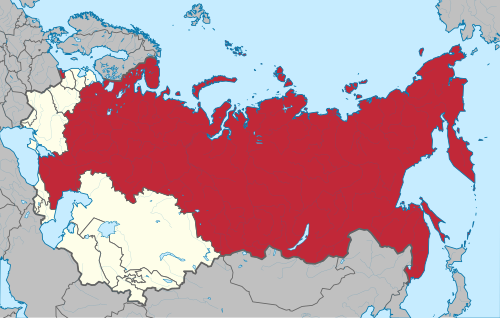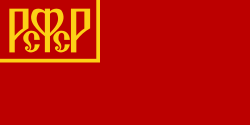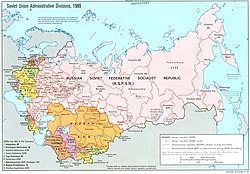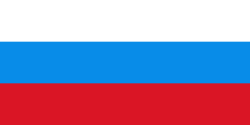Russian Soviet Federative Socialist Republic
The Russian Soviet Federative Socialist Republic (Russian SFSR or RSFSR; Russian: Российская Советская Федеративная Социалистическая Республика, IPA: [rɐˈsʲijskəjə sɐˈvʲetskəjə fʲɪdʲɪrɐˈtʲivnəjə sətsɨəlʲɪˈsʲtʲitɕɪskəjə rʲɪˈspublʲɪkə] (![]() listen)), also known as the Russian Soviet Republic[9] and the Russian Socialist Federative Soviet Republic,[10] as well as being unofficially referred to as Soviet Russia,[11] the Russian Federation,[12] or simply Russia, was an independent socialist state from 1917 to 1922. Afterwards it was the largest and most populous socialist republics of the Soviet Union (USSR) from 1922 to 1991. When the Soviet Union collapsed, the Russian SFSR became the Russian Federation.[13]
listen)), also known as the Russian Soviet Republic[9] and the Russian Socialist Federative Soviet Republic,[10] as well as being unofficially referred to as Soviet Russia,[11] the Russian Federation,[12] or simply Russia, was an independent socialist state from 1917 to 1922. Afterwards it was the largest and most populous socialist republics of the Soviet Union (USSR) from 1922 to 1991. When the Soviet Union collapsed, the Russian SFSR became the Russian Federation.[13]
Russian Soviet Federative Socialist Republic Российская Советская Федеративная Социалистическая Республика Rossiyskaya Sovetskaya Federativnaya Sotsialisticheskaya Respublika[1] | |
|---|---|
| 1917–1991 | |
| Motto: | |
| Anthem: | |
 The Russian SFSR (red) within the Soviet Union (red and white) between 1956 and 1991 | |
| Status |
|
| Capital | |
| Official languages | Russianb |
| Religion |
|
| Demonym(s) | Russian |
| Government |
|
| Head of state | |
• 1917 (first) | Lev Kamenevc |
• 1990–1991 (last) | Boris Yeltsind |
| Head of government | |
• 1917–1924 (first) | Vladimir Lenine |
• 1990–1991 | Ivan Silayevf |
• 1991 (last) | Boris Yeltsing |
| Legislature |
|
| Historical era | |
• | 7 November 1917 |
| 1917–1923 | |
• Soviet republic proclaimed | 25 January 1918 |
| 30 December 1922 | |
| 19 February 1954 | |
| 12 June 1990 | |
| 12 December 1991 | |
• Russian SFSR renamed into the Russian Federation | 25 December 1991 |
• | 26 December 1991 |
| 25 December 1993 | |
| Area | |
| 1956[source?] | 17,125,200 km2 (6,612,100 sq mi) |
| Population | |
• 1989[source?] | 147,386,000 |
| Currency | Soviet ruble (Rbl)h (SUR) |
| Time zone | (UTC +2 to +12) |
| Calling code | +7 |
| ISO 3166 code | RU |
| Internet TLD | .su |
| |
Seven Hero City awards The Russian Democratic Federative Republic existed briefly on 19 January 1918, but actual sovereignty was still in the hands of the Soviets even after the Russian Constituent Assembly opened its first and last session in 1918.[8] | |
Russian Soviet Federative Socialist Republic Media
- Soviet Union location map (1937).svg)
- Soviet Union location map (1937).svg and
- Soviet Union location map (1937).svg and
- Soviet Union location map (1937).svg and
The Battle of Stalingrad, considered by many historians as a decisive turning point of World War II
References
- ↑ Historical names:
- 1918: Russian Soviet Republic (Российская Советская Республика; Rossiyskaya Sovetskaya Respublika)
- 1918–1936: Russian Socialist Federative Soviet Republic (Российская Социалистическая Федеративная Советская Республика; Rossiyskaya Sotsialisticheskaya Federativnaya Sovetskaya Respublika)
- 1936–1991: Russian Soviet Federative Socialist Republic (Российская Советская Федеративная Социалистическая Республика; Rossiyskaya Sovetskaya Federativnaya Sotsialisticheskaya Respublika)
- ↑ Arthur Ransome (16 March 1918). "Lenine's Migration A Queer Scene". Archived 16 September 2018 at the Wayback Machine. The New York Times.
- ↑ After the October Revolution, the Bolsheviks, the Left SRs, and the Menshevik-Internationalists formed a Socialist coalition government that lasted until March 1918 (Historical Dictionary of the Russian Revolution. J. Davis. p. 58); the Mensheviks were allowed to legally hold a congress in 1920 and continued to be elected to the Congress of Soviets until being outlawed in 1921 (Lenin's Legacy. R. Wesson, 1978).
- ↑ Historical Dictionary of Socialism. James C. Docherty, Peter Lamb. Page 85. "The Soviet Union was a one-party Marxist-Leninist state."
- ↑ "Law of the USSR of 14 March 1990 N 1360-I 'On the establishment of the office of the President of the USSR and the making of changes and additions to the Constitution (Basic Law) of the USSR'". Garant.ru. Archived from the original on 13 August 2011. Retrieved 12 July 2010.
- ↑ article 114 of the 1937 Constitution, article 171 of the 1978 Constitution
- ↑ R. W. Davies; Mark Harrison; S. G. Wheatcroft (9 December 1993). The Economic Transformation of the Soviet Union, 1913–1945. Cambridge University Press. p. 6. ISBN 978-0-521-45770-5.
- ↑ Riasanovsky, Nicholas (2000). A History of Russia (sixth ed.). Oxford University Press. p. 458. ISBN 0-19-512179-1.
- ↑ Cite error: Invalid
<ref>tag; no text was provided for refs namedautogenerated1. - ↑ Besier, Gerhard; Stokłosa, Katarzyna (2014). European Dictatorships: A Comparative History of the Twentieth Century. Cambridge Scholars Publishing. p. 67. ISBN 9781443855211.
- ↑ Declaration of Rights of the laboring and exploited people (original VTsIK variant Archived 7 August 2011 at the Wayback Machine, III Congress revision), article I.
- ↑ Colloquially referred to as such for short in intra-Soviet politics (along with the adjacent "Transcaucasian Federation" in the south until 1936). See for example, the log of the meeting of the Supreme Soviet of the USSR on 19 February 1954 Archived 12 September 2012 at Archive.today. The Russian SFSR officially renamed into the Russian Federation on Christmas Day, 25 December 1991.
- ↑ The Free Dictionary Russian Soviet Federated Socialist Republic Archived 13 August 2011 at the Wayback Machine. Encyclopedia2.thefreedictionary.com. Retrieved on 22 June 2011.











